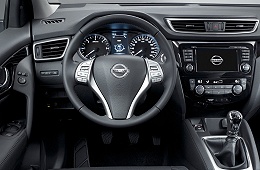|
|
VS |
|
This is the Nissan Qashqai Vs Mitsubishi Eclipse Cross comparison for 2018. Both arecompetitors in the small-medium sized SUV class, with similar pricing and features meaning this comparison was bound to happen. We like the Qashqai for a number of reasons although the Eclipse Cross is currently too new to form a lasting impression, at least until we do a few more comparisons like this one.
Nissan Qashqai Vs Mitsubishi Eclipse Cross exterior comparison: The Qashqai is a good looking SUV and although 3 years old it still looks contemporary in 2018. The updated front end does make it more aggressive and we think looks better for it. Overall though the design is on the conservative side but who cares when it works this well? The Eclipse Cross uses the wedge theme and the current ‘Alien’ inspired front end works really well. That said the rest of the design is even more conservative than the Qashqai but it still good in a different way. It reminds us of the Lexus minus the floating roof element so popular in 2018. The split rear windows adds 1980’s Honda CRX and 1990’s Pontiac Aztec deign touches which makes it one of the largest rear windows of a small-mid sized SUV.
Nissan Qashqai Vs Mitsubishi Eclipse Cross interior comparison: The Qashqai has a good looking and feeling interior. However the design is conventional, with soft touch plastics in a matt finish and minimal use of cheap looking hard plastics is rare in this class. In top range trim it looks an feels good but not as nice as say the 3008 but for the Qashqai’s asking price is perfect. The interior of the Eclipse Cross can be described as modern and overall nice. The tiered centre console and tablet screen is very 2018 in design and the materials can be described as class standard with a mix of soft and hard plastics that look good together. The track pad looks like an afterthought and more controls on the steering wheel would be the more useful for a new model. That said the steering wheel is the common feature in all current Mitsubishi’s and it needs a higher quality steering boss and controls as it doesn’t really fit. Finally the in terms of size the Eclipse Cross has more space and flexibility.
Nissan Qashqai Vs Mitsubishi Eclipse Cross engine and technology comparison: The Eclipse Cross has the latest CVT tech of predefined ‘gears’ and engine designed to suit the engine. Mitsubishi Motors of 2018 is about SUVs designed to have current technology and offer great value. The Eclipse represents this and has all the the latest safety features and in-car entertainment systems at least in the top range model. The Qashqai uses the same corporate philosophy except with Nissan design. All it’s tech except for Apple and Android direct connectivity and missing the turbo engine otherwise is pretty much the same. Both include all around cameras, huge sunroof, auto brakes etc… that said Nissan, Mitsubishi and Renault are owned by the same overall company in 2018. Furthermore while it’s handy to have, we don’t think that Apple or Android connectivity is a killer feel anymore.
Nissan Qashqai Vs Mitsubishi Eclipse Cross drive report: N/A
The conclusion and winner of the Nissan Qashqai Vs Mitsubishi Eclipse Cross comparison is a draw. The Qashqai has lots to offer in terms of the overall package and then the looks. The only thing that lets it down is the CVT and non-turbo engine is Ok the last time we drove one. The Eclipse Cross has the better spec drive train more modern design although it still doesn’t feel as comfortable as the Qashqai. Which SUV you buy ignoring the brand will probably be based on which one looks better to you or perhaps better performance and price hence the equal rating from us.
| Nissan Qashqai | Mitsubishi Eclipse Cross |
 |
 |
| Engines | |
| 4 Cylinder petrol (91 Octane) 2.0 Litre (1998cc) DOHC VVT EFI Claimed 110Kw @ 6000RPM Claimed 197Nm @ 4200RPM |
4 Cylinder Petrol 91 Octane 1.5 Litre (1499cc) DOHC VVT DI EFI Claimed 110Kw @ 5500 RPM Claimed 250Nm @ 2000 RPM |
| Weight | |
| Kerb weight 1340 Kg Towing capacity up to 1400kg |
Kerb weight FROM 1490Kg Towing capacity up to 1600kg |
| Fuel capacity & consumption | |
| Up to 63 litres IL4 2.0 Petrol 7.7 litres per 100km IL4 2.2 Diesel 5.8 litres per 100km |
Up to 63 litres IL4 1.5 litre Petrol 7.3 litres per 100km |
| Other specifications | |
| 5 speed manual or CVT Auto Overall height/width 1615/1770 Overall length/Wheelbase 4295/2690 4WD system: FWD or AWD ANCAP Safety: 5/5 |
6 speed manual or CVT Auto Overall height/width 1685/1805 Overall length/wheelbase 4405/2670 4WD system: 2WD or AWD ANCAP Safety: 5/5 |
| Capability | |
| Angle of: (degrees) Approach xx Departure xx Breakover xx Ground clearance (unloaded) 219mm Water Fording depth xxmm Max |
Angle of: (degrees) Approach 18.8 Departure 29.6 Breakover 18 Ground clearance (unloaded) 175 mm Water Fording depth xxmm Max |
| Performance | |
| – | |
| Pricing | |
| 2018 $25,000 – 37,000 AUD 2017 $25,000 – 37,000 AUD 2015 $24,990 – 35,490 AUD 2013 $24,990 – 36,490 AUD |
2018 $30,550 – 38,500 AUD *Always check with the dealer for up to date pricing, specifications, on-road costs, accessories and specials etc.. everything as usual is subject to change! |





